The Double-Slit Paradox Resolved
How a novel approach to Hugh Everett’s “Many-Worlds Interpretation” pulls back the veil on quantum probability and radically alters our understanding of time and space
In 1801 Thomas Young found that by shining light through two slits at once, a wave interference pattern was produced in the light and shadow on the wall behind the openings, the same sort of interference we would expect from waves of water. This discovery became the basis of his wave theory of light, but he could not have known how much deeper the rabbit hole would go, that similar experiments would continue to puzzle scientists over two hundred years later.
In 1927 a double-slit experiment was performed by Davisson and Germer, but instead of shining a continuous beam of light at the slits, they fired individual electrons, one after another. After passing through the openings the electrons would strike a crystalline nickel target, recording the impact with the appearance of a tiny, shining dot. It was suspected that the sum of the impacts would amount to two clusters of dots (one cluster behind each slit, as we would expect from a classic projectile), but in fact the dots gradually formed a wave interference pattern like that observed in the Young experiment. The electrons, fired one at a time, were somehow interfering with themselves like waves, then striking the back wall like point particles. The same phenomenon was observed with larger particles…
